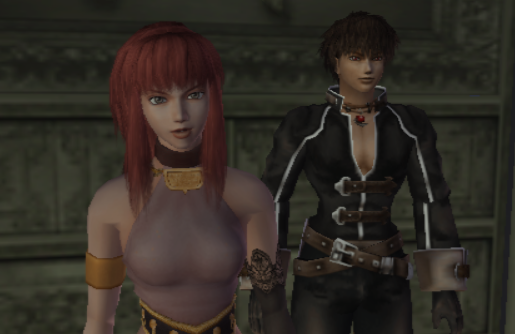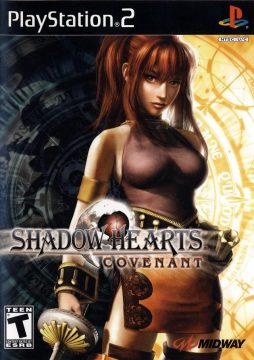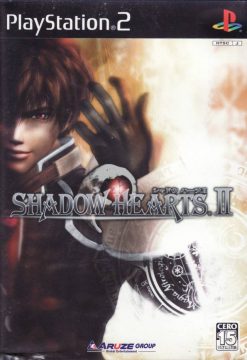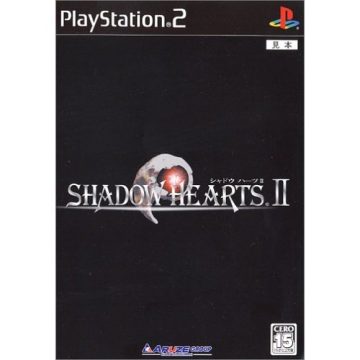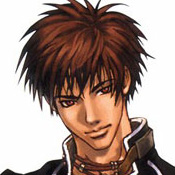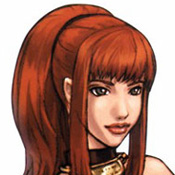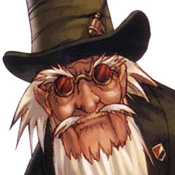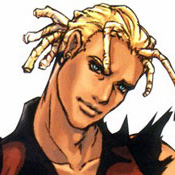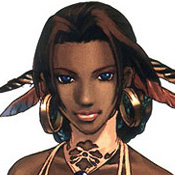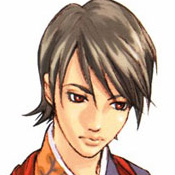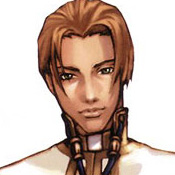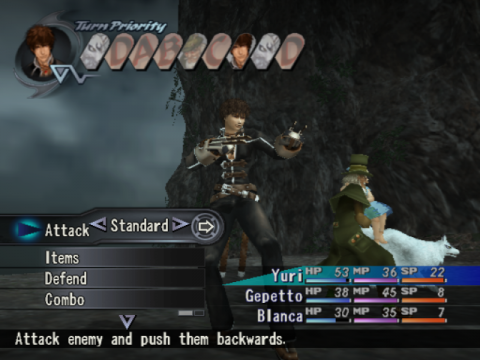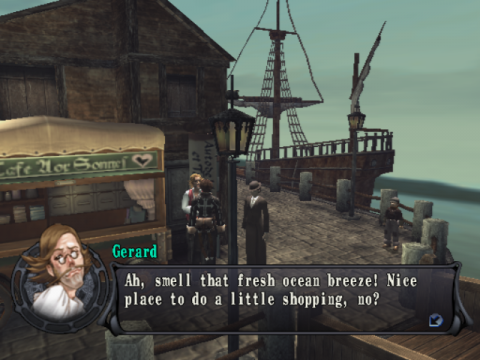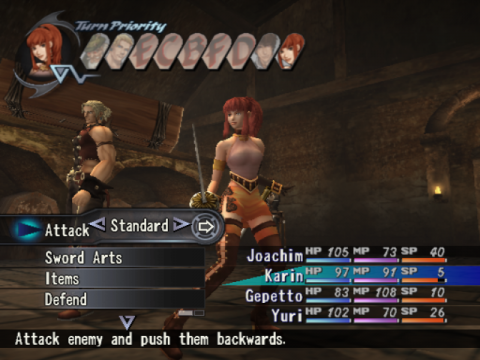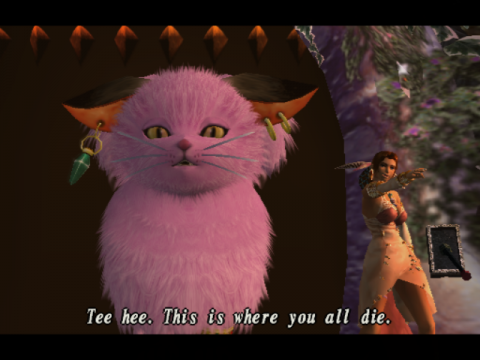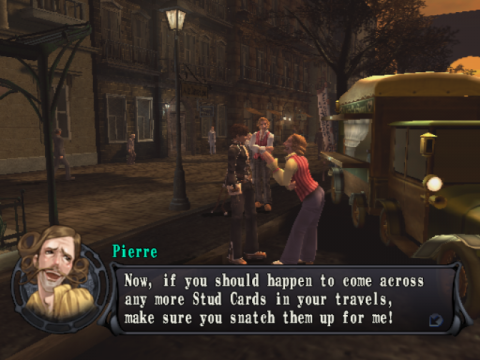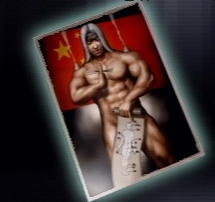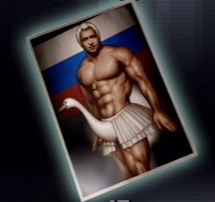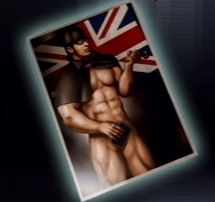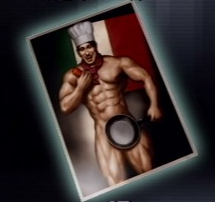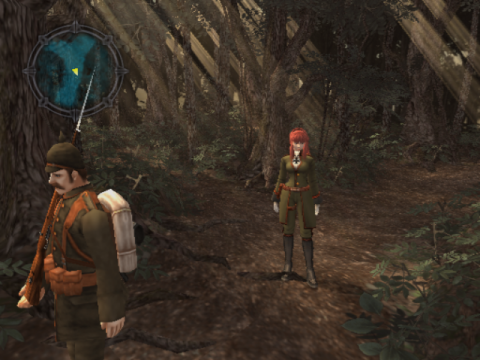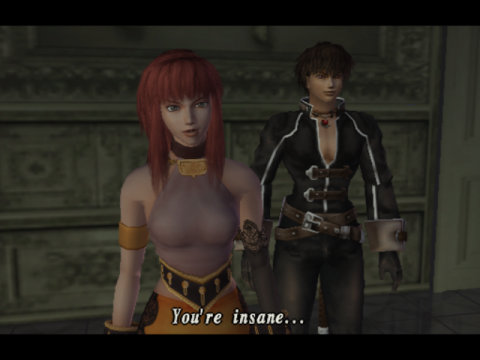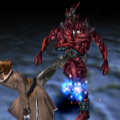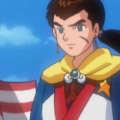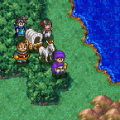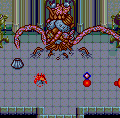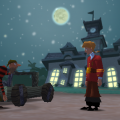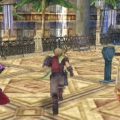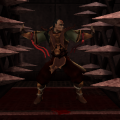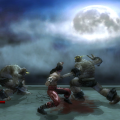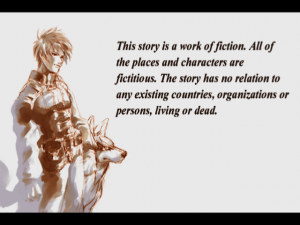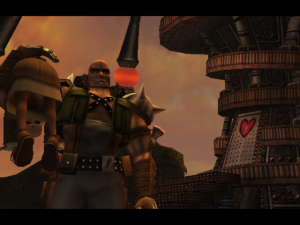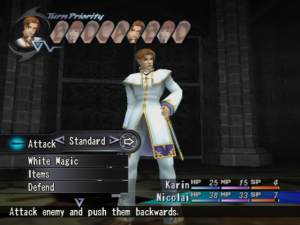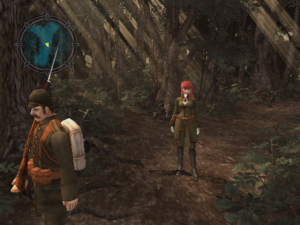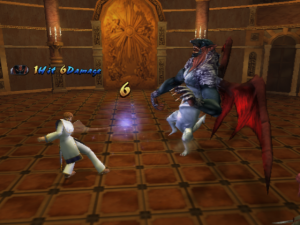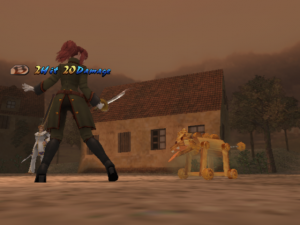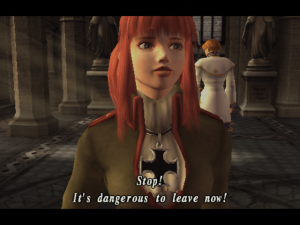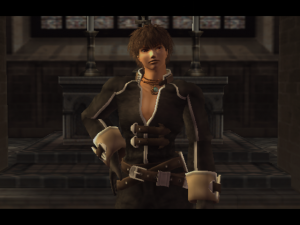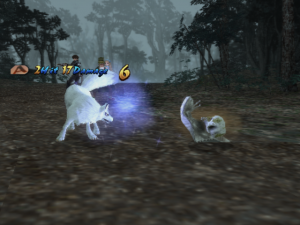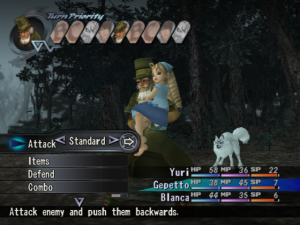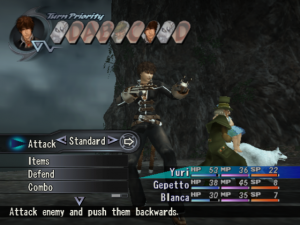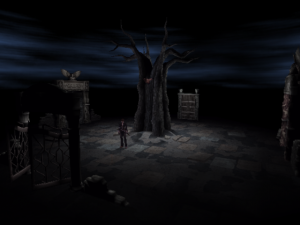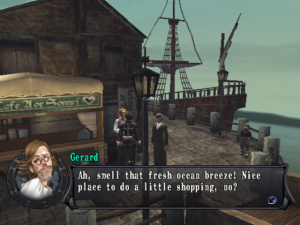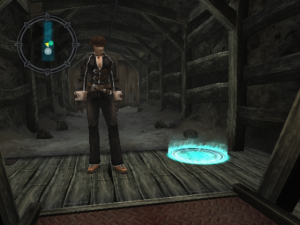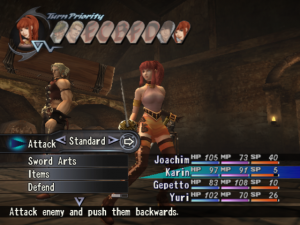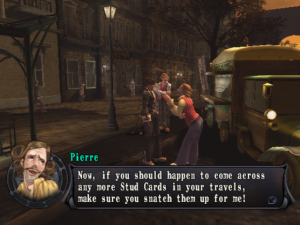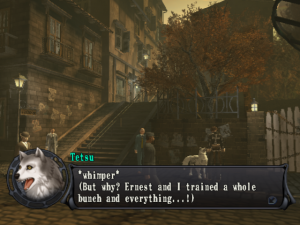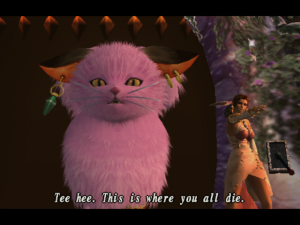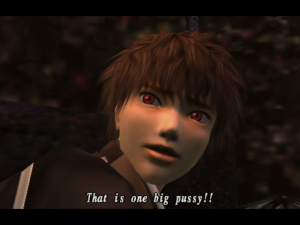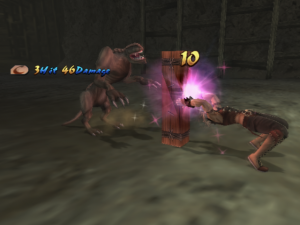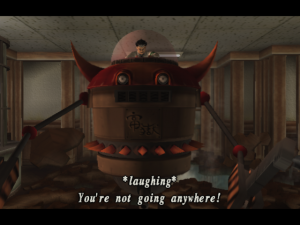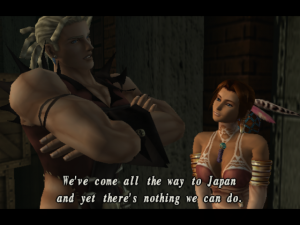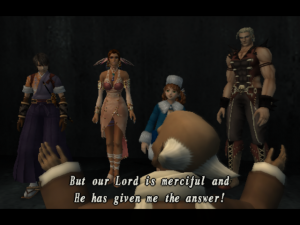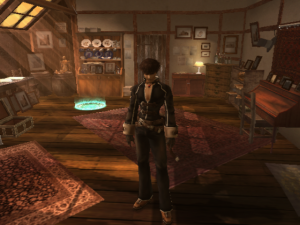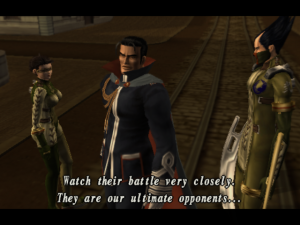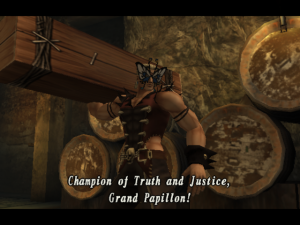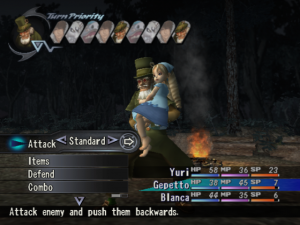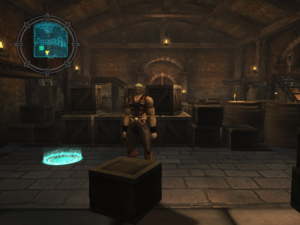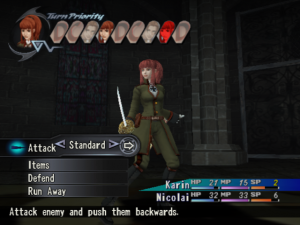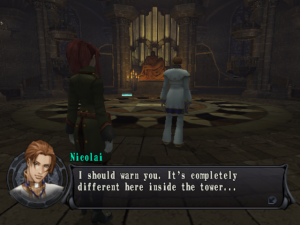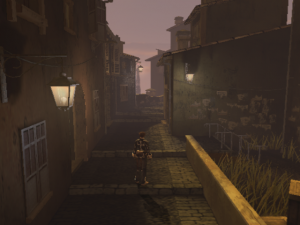- Koudelka
- Shadow Hearts
- Shadow Hearts Covenant
- Shadow Hearts: From the New World
Though Shadow Hearts had made it out the door in time for Sacnoth to engrave their name on it, Aruze’s acquisition of SNK and its assets finally caught up with the group not long afterwards: thankfully, their new baby had garnered just enough positive attention for the suits to both keep the development team intact (despite changing their moniker to “Nautilus”) and give the all-important green light to a sequel. After a few years of work this second chapter, which would again be brought Westward by Midway with the added subtitle “Covenant” (and an offer to receive a copy of the first game for free if you pre-ordered in the USA), finally made it to market, and thank goodness it did, for this is the point at which the series truly hits its stride.
In an unusual twist, the first game’s “bad” ending has been evoked as its (more-or-less) canon conclusion, and as a result Yuri’s hard-fought victory over both his outward enemies and inner demons has exacted a painfully heavy final price: Alice’s life. Of course, the coinciding march of real-world history only makes matters more depressing, for while mankind has been spared all-enveloping supernatural darkness, it turns out that he doesn’t need any help to unleash a globe-altering cataclysm, and the first World War erupts before Yuri or his friends have so much as a chance to exhale.
Eighteen months after they resignedly go their separate ways, however, malevolent forces beyond the grasp of mere mortals are stirring with newfound strength amidst all the chaos: seeing as our social studies textbooks have done a shamefully inadequate job of covering this side of the story, the onus falls to video games to keep the public duly informed about what realy happened.
Characters
Yuri Volte Hyuga
Once again lacking direction or aspirations for himself following Alice’s untimely passing, Yuri eventually wends his way to the remote French village of Domremy, which he settles into and defends from invasion once Axis forces begin to loom on the horizon. Time and loss have softened his countenance a bit, as he’s more susceptible to periods of quiet contemplation than he used to be, but when push comes to shove he still relishes any opportunity to say “bite me” to some looming, emoting underworld demi-god sorely in need of an attitude adjustment. His signature fusion powers are sealed away by yet another curse early on, but it’s not long before he sets out to earn all of his “special friends” back and resume kicking some unholy ass.
Karin Koenig
A German army lieutenant whose once-distinguished family name has fallen on hard times, Karin and her unit are one of many would-be occupiers of Domremy to be chased off by the town’s mysterious “guardian”. When she’s sent back for a second try things quickly escalate beyond what she signed up for, and she finds herself fleeing for her life not from Yuri but alongside him; tragically, she gradually begins to harbor feelings for the young man, despite knowing full well that his heart already belongs to Alice. A balanced user of both physical attacks and magic, she also (somehow) learns a handful of unique sword techniques by tracking down scattered musical scores from Wagner‘s Nibelung opera cycle.
Gepetto
Alice’s elderly uncle and a famous puppeteer who, after the sudden death of his only daughter, retired to Domremy and met a sullen Yuri there. The latter, as it turned out, had just arrived from Zurich, where he had laid Alice to rest with his own hands; Gepetto decides to stick by the young man until fate takes him elsewhere. Like Zhuzhen before him Gepetto is chock full of helpful information and experience, though at times his better judgment is overtaken by a weakness for liquor and/or lechery. He fights indirectly, via a favorite marionette named Cornelia: buying and equipping different costumes for her both changes his elemental affinity and unlocks new special spells for his use.
Blanca
A friendly white wolf “adopted” by a certain young girl from Domremy (guess her name, history buffs…and Wikipedia readers), he helps Yuri watch over the village and continues to follow after him once he’s forced out. Intelligent and resourceful, Blanca’s animal instincts provide his human compatriots a way out of numerous tight spots, though he’s frequently frustrated by the fact that they can’t understand (and often misinterpret) what he’s trying to tell them. Throughout the game he can challenge other wolves he meets to one-on-one bouts (Fatal Fury fans will get a particular kick out of one of them): victory brings new attacks and treasures, as well as tidbits of insight into his past.
Joachim Valentine
Keith’s older brother is about as disparate a personality from his kin as you could possibly imagine: a showboating but well-meaning (and ambiguously gay) muscle-head, Joachim lays the smack down with a combination of large blunt objects he finds lying around (from tables to mailboxes to statues to the classic frozen tuna) and over-the-top pro wrestling techniques. What’s more, his “unique biorhythms” periodically shift his body between several different forms with varying stats and abilities, including sentai-style masked super-hero Grand Papillon. Even in a game hardly wanting for colorful personalities, Joachim may well take the crown as the strangest of them all.
Lucia
An orphan raised and trained in the arts of dancing and fortune-telling by a onetime Florentine beauty named Carla, Lucia’s physical allure and grace are equaled only by her bubbly, perky and somewhat ditzy personality. Initially suspicious of the party (not that one can blame her, really), she’s urged by Carla to join up after they win her trust…and survive a series of clumsy attempts to do them in. During battle she can mix a variety of Aroma Oils together to add support effects to allies, or randomly produce a Tarot card from her deck, which may either help or hinder your situation depending on the luck of the draw.
Anastasia Romanov
While her real-world counterpart‘s story was cut short by the Russian Revolution, this game’s version of the young princess is defined by her tireless pursuit of unapproved snacks (much to the chagrin of the exasperated palace guards) and a fierce desire to do what she can to help her country, even if it means leaving home to adventure with Yuri’s band. Covenant’s resident “blue mage”, she brandishes a camera to snap pictures of enemies and reveal their vital stats; certain adversaries will also bestow special abilities when photographed. Curious and tactless to no end, she frequently schemes and squabbles with the lumbering Joachim.
Kurando Inugami
A polite, disciplined samurai from a backwater Japanese village, he agrees to travel with the group after Yuri helps him defend his master and the latter’s adopted daughter (based off of an actual Japanese spy and the Chinese princess he expatriated and raised) from repeated ambushes. Kurando possesses “Fusion” abilities similar to Yuri’s, though more limited in scope – the player finds out precisely why before long. The 14-year-old Anastasia, as it happens, develops a rather sudden and slightly uncomfortable crush on him; Kurando’s reaction, like ours, is one of befuddlement above all else.
Nicolai Conrad
Initially identified as a representative from the Vatican assigned to assist Karin on her return trip to Domremy, in truth Nicolai is affiliated with a reclusive underground society known as Sapientes Gladio (“Sages of the Sword”), who were covertly working on the same side as Yuri in the first game but have since become opposed to the so-called “Godslayer”. Smooth-tongued and self-confident, he quickly turns ruthless if things aren’t going his way. Rumor has it that Nautilus was actually considering making him Covenant’s primary protagonist early in the design process, though concrete info on this possibility tends to be elusive.
For players of the original Shadow Hearts, the first thing likely to stand out in the sequel is how much more “open” almost everything feels: bringing the “wrong” party or equipment to a given area used to mean drudgery-a-plenty, but here you can almost always do fine no matter who’s up to bat, so long as you take a little time to make sure you’re “generally” well-prepared. While everybody on your team still sports their own unique combat abilities, this time most of them can also be outfitted with magical “crests” (bearing names borrowed from demons featured in the “Goetia” segment of the apocryphal Lesser Key of Solomon) which enable a variety of interchangeable “common” elemental spells.
There are few restrictions, aside from an overarching “Dominance Capacity Point” (DP) limit, on who can be equipped with what, which translates to a much-needed injection of flexibility into your available battle strategies. Yuri is unable to equip Crests, but in exchange can access all of his Fusions at once; as an added boon, transforming now consumes a set amount of extra SP per action instead of a big chunk upon activation, so if you accidentally select the wrong creature you don’t need to risk going Berserk to fix your mistake.
The overall flow of the game, in fact, has taken a more relaxed approach, as you’re far freer than before to check previous areas to make sure you haven’t missed anything, or venture off to the side for a break from the main quest. Naturally, there are still lots of elusive nuggets that you’ll drive yourself nuts tracking down, especially towards the end, but most of the time you can seek them out more or less at your leisure. You’ll also still venture into Yuri’s inner “Graveyard” to enhance his abilities, but thanks to Alice’s sacrifice (and good design sense) both element-specific Soul Energy and the “Malice” system have been canned, so not only can you unlock new fusions in any order you please, but there’s no more threat of a sudden Game Over looming over your head if you just feel like meandering around for awhile.
Nowhere, though, is this heady sense of freedom more evident than within the retooled and spit-shined Judgment Ring: the vestigial “acupuncture” service has been mercifully replaced with a wide and welcome variety of free-form means to tweak the Ring’s performance to your liking. Almost right from the get-go you’re able to choose from several basic “styles” of Ring, which can be switched up at will via the main menu: you’re free to exchange raw power for more forgiving timing (or vice-versa), enable a one-shot “gamble” Ring, or even disable manual Ring input altogether if you’d rather not bother with it.
Items to adjust the Ring’s hit areas, speed, and other characteristics (including adding status effects to your physical attacks) are far more plentiful than before and can be equipped or unequipped relatively easily, which basically gives you the wherewithal to customize the game’s most prominent system to your own preferred specifications. Newbies can ease into the swing of things, veterans can challenge themselves for greater rewards, and the mostly-pointless “event” Rings are gone too, so now every time a Ring pops up you know something is truly at stake.
Battle, of course, is where most of this stuff comes into play: in addition to the aforementioned customization options a bevy of new combat features are on tap to keep things interesting. First and foremost, combat now occurs in “actual space” – participants on both sides will constantly break formation to deal physical strikes, or cast spells to slam enemies away and even into walls. Unlike Lunar or Grandia there’s no “move” stat to consider, and thus no real need to ever worry about being “out of range”, but positioning must still be taken into account since most special attacks and magic have a limited area of effect. To help keep track of this more involved brand of combat the overall turn order is now displayed onscreen, as is an HP meter for enemies, which makes formulating and adjusting strategies mid-fight much easier.
By the by, four party members can brawl at a time, up from the first game’s max of three, and two or more of these can pool their efforts via the newly-minted “Combo” tactic. When someone’s turn comes up, you can opt to delay their action and instead have them run over and link up with someone else farther down the line; once the latter takes his/her turn the waiting member(s), following a quick button prompt, can then immediately follow up, and the more consecutive hits are landed the greater the damage bonus you get. To maximize effectiveness, everyone’s standard physical attacks can be directed to knock enemies into or out of the air, or farther away, to set them up for the next step of the beating; if you can successfully orchestrate a full-party Combo you have the option of finishing it off with a super-powerful special spell. Lastly, as you use certain party members more often their “Affinity” for each other will gradually increase, leading to more effective Combos.
A bit of experimentation is required to determine which sequences work best (i.e. if Member A uses a strike that knocks a lightweight enemy high into the air and Member B follows up with a ground-based move, the latter will whiff and the chain will break…on a heavier opponent, however, the combination might work), but it’s not all that hard to figure out. Some enemies can Combo you, too, though both they and your allies can be nudged out of (or occasionally into) the setup formation with a strong enough blow: there is a special “Resist” defensive option to prevent this, but it costs SP. Speaking of which, Sanity Points are no longer your only motivation to always do your best in battle: finish things up extra-quickly, without taking damage, or in a couple of other “above-and-beyond” fashions, and you’ll receive a bit of bonus money, items, and/or experience, which can add up nicely if you’re consistent.
While still not as sweepingly “epic” as some of its RPG brethren, Covenant is definitely a bigger production than its elder sibling: though its pacing is generally faster, the game now spans two discs and will likely command around twice the original’s play time to finish. You’re still restricted to destinations around Eurasia, but you’ll visit a wider variety of places and hobnob with even more (jazzed-up) historical figures than last time, including famed British military officer Lawrence of Arabia, Indian wrestling legend The Great Gama, and Russia’s infamous “Mad Monk” Rasputin. Some of the everyday townspeople will also flap their jaws about artists and other personalities of the day, so those with a yen for history will have plenty of (half-accurate) tidbits to take in as they progress. Dungeons are likewise much larger and more labyrinthine than before, and as a result getting lost now rears its head as a less-than-inviting possibility, but a mini-map offers at least a little help in finding (or re-finding) your way.
Despite tossing players several more balls to juggle than the first game did, the sequel’s focus on flexibility makes for an easier quest to finish all around: a few might argue that the first Shadow Hearts‘ sometimes-frustrating brand of challenge was an integral part of its je ne sais quoi, but the majority will be none too heartbroken to see most of the insta-deaths and grinding boss battles gone for good. Some nifty new shortcuts, such as the ability to pre-set favorite party formations and assign “combo” strings to single buttons, will render them even less likely to gaze too despondently over their shoulders.
That all being said, it’s confession time: when I stated earlier that Covenant‘s “openness” would be the first thing you’d notice about it, I lied. That distinction belongs to the much-improved graphics. While the game doesn’t quite reach the topmost tier of PS2 visuals, it’s still impressive to look at, especially considering the rather spartan foundation it’s been built up from. The mostly-lifeless pre-rendered backdrops have finally been ditched in favor of real-time environments, while character and enemy models, particularly in terms of facial expressions, have been drastically spruced up. Even with the fresh coat of paint animations are still silky smooth, and the lauded CG cutscenes are even more impressive to behold than they were last time.
If there’s a potential downside to the presentation, however, there is some truth to the notion that it’s not quite as distinctive as it might be – though there are certainly some revolting creatures slithering around, the first game’s marquee horror flavoring has been inarguably pared back, as reflected in a less-restrictive “Teen” ESRB rating. On the flipside of the coin, the humor quotient has been well and truly let off the leash: a parade of bizarre personalities and situations is on hand for players to gawk at in disbelief, from an out-of-nowhere Metal Gear Solid spoof sequence (proof positive that yes, it is possible to make Metal Gear Solid even sillier than it already is) to a giant, fluffy pink kitty-cat boss (prompting the inevitable “That is one giant pussy” outburst from Yuri). To be sure, straight-up comedy isn’t a whole lot more common than horror when it comes to JRPGs, so the overall mood does still stand out from most of the competition. One long-running side mission in particular, involving hunting down “stud” cards was…interesting enough by itself to inspire a Penny Arcade comic strip.
To some extent, the same principle applies to the game’s aural elements. Hirota and Mitsuda are back on the job, with newfound assistance courtesy of Kenji Ito (the “SaGa” series and others) and Tomoko Imoto (nee Kobayashi). Covenant‘s music takes things in a bit more of an orchestral direction, and thus remains just as fitting to the occasion, though this in turn means that some of the most unique, eerie interludes aren’t as prevalent; there are still sections that can make your hair stand on end, especially as you get farther in and encounter some of the ickier baddies, but generally speaking, while the music makes for a great listen, it’s also a touch more predictable in nature than its predecessor’s was. Character voices, for their part, are much more prevalent both in and out of battle, and hey, Midway (employing none other than Konami veteran Jeremy Blaustein) actually bothered to translate the whole thing this time – a majority of the English VAs do a good job, though it wouldn’t be a localized JRPG without some mismatched text and cringe-worthy lines sprinkled in.
In any event, you’ll have to pardon the cliché, but there’s really no avoiding it: in nearly every respect, Covenant truly does take what was good about the first Shadow Hearts and make it better, smoothing out both literal and figurative rough edges to put together a better-executed and all-around more enjoyable package. These welcome developments did not go unnoticed by either players or reviewers, as the sequel elicited a much warmer welcome to retail than the original: most fans today still cite Covenant as their undisputed pick of the litter.
Of course, with great popularity comes great heaps of swag and other promotions: another 2-disc soundtrack and a complement of guides and artbooks are no-brainers, but how about, say, a cell phone fan club (featuring ringtones, wallpapers and the like), phone cards, calendars, tote bags, alarm clocks, music boxes, a TGS promo DVD, and pre-made cosplay outfits? While some Japanese copies of Shadow Hearts II were again afflicted with a save bug (the transition to Disc 2 could corrupt your file; victims could mail their card in to have the data fixed), the country was also the only one to receive a “Limited DX Pack”, which threw in a cell phone strap, choker and pouch, media DVD, and a pair of Judgment Ring drink coasters(!) alongside the game for a few thousand yen extra.
More depressing for Westerners, though, is the fact that they missed out on the “Director’s Cut” re-release that Japan got about a year after the original printing: similar to the “FES” edition that Persona 3 would receive in 2007, it not only retailed for a “Best” label’s discount price but included some supplemental content. Most of it is pretty standard “omake” fare, like new items, music, and plot scenes, plus HDD support and a few other tweaks; the main attractions here are a pair of additional dungeons. One is an optional end-game side trip with an über-boss at the end, but the other is a sudden cut-away in the middle of the story, during which you get to temporarily play as Nicolai and two other central villains. The extras on offer aren’t exactly indispensable, but they are nice bonuses for anyone with access to them; as it happens, owners of the later-released PAL version with enough technical know-how can actually dig up some of the hidden stuff nestled away in the coding.
In any case, non-Japanese fans must have been thrilled all the same to glimpse a poster, cardboard standee or even a themed employee “pre-order now!” pin in brick-and-mortar stores around release time, a surefire indication of just how much hard-earned clout (relatively speaking) the series could now boast. More Shadow Hearts, they could be certain, was on the way.
